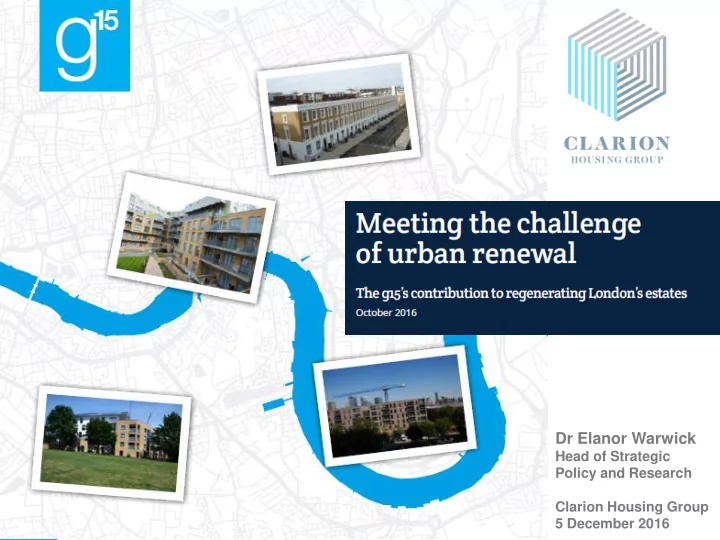

Dr Elanor Warwick Head of Strategic Policy and Research Clarion Housing Group 5 December 2016
The changing context for regeneration 1997 LB Sutton begin talking with residents 2016: 500 th home completed 2002 Affinity Sutton involved The Lavenders, Sutton. Affinity Sutton
Countering the myths that regeneration results in: • Loss of housing • Market sale units squeezing out low cost/rent affordable housing • Over densification is ‘cramming in’ units on regenerated estates • Existing residents being priced out • Communities are displaced elsewhere • Housing associations cherry-pick locations to make most profit . • Commitments to residents are ignored 35 London regeneration schemes completed between 2013 and 2015, on-site now or in the pipeline until 2040.
Location of g15 regeneration schemes with average house price values
Targeting areas to alleviate deprivation • Replacing poor quality stock most frequently cited driver for regeneration. Improving deprived neighbourhoods the second. • An Index of Multiple Deprivation (IMD) score at the start of regeneration was available for 34 of the 35 schemes. • All but five schemes had an IMD score that was higher than the score for the LA in which they are situated. • Confirming g15’s regeneration programmes are focussed on transforming struggling communities in London.
Extent that HAs are funding regeneration themselves • Data on grant and non-grant investment provided for 29 schemes. • Total scheme costs for these were £4.8bn, of which 10% was identified as grant from a variety of public sources. • The definition of public subsidy is muddied by the issue of land - in most cases land was not provided by LAs for free - but may have been at a discounted rate or subject to other conditions. • Regeneration requires substantial up-front investment - seed funding is required at an inherently risky stage given the initial uncertainty as to whether a scheme will proceed. In the context of reduced / no public subsidy who will pay for regeneration?
Increasing tenure mix - tenure of units before / after regeneration
Scaling up output - cumulative unit completions by tenure (forecast 2016-2040)
Locally appropriate density and tenure mix
Residents shaping designs and programme “There is a whole community here who have collaborated to bring this scheme together for the good of all; all the choices have been truly collective. Residents have taken ownership of the decisions around their estate by becoming involved” 11 | Section title L&Q resident Haggerston
g 15’s regeneration philosophy • A regeneration philosophy which is focused on the resident . Fostering community involvement in the process and incorporating resident views into the design of new homes and their neighbourhood . • Working to ensure new housing is affordable to existing residents while providing new low cost homes for rent and ownership to help young Londoners get on the housing ladder . • A promise to deliver high quality, safe, warm, new homes abiding by best practice standards of design . • Acknowledging our long-standing obligation to communities . We will commit to all existing management obligations to support communities over the lifetime of the neighbourhood. • Resulting in the delivery of refreshed and modernised neighbourhoods with improved facilities and a chance to meet new neighbours from all walks of life .
Support and partnership required to unlock urban regeneration potential • A stable policy environment which provides the flexibility Housing Associations need to deliver new projects; • Certainty over rental income to provide the finance necessary for new and refurbished homes; • Increased public subsidy and greater flexibility over how funding may be used; • Active support in targeting estates that would benefit from regeneration; and • Leadership and partnership in the planning and delivery of successful schemes.
Thank you Elanor.warwick@clarionhg.com Packington Estate. Hyde Group
Recommend
More recommend